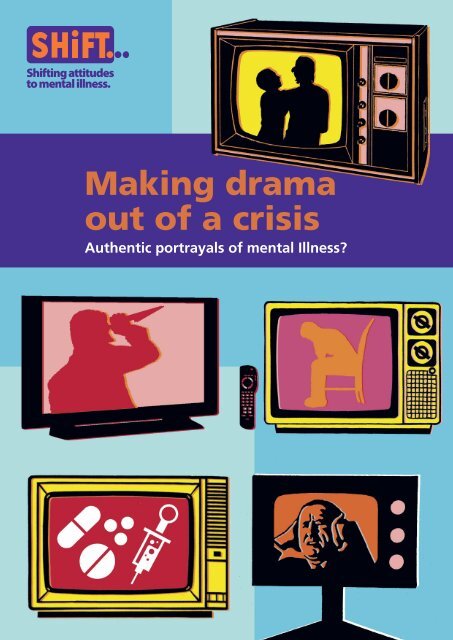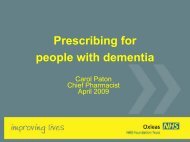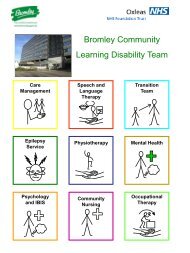Making a drama out of a crisis - SHiFT summary report 988.3 KB
Making a drama out of a crisis - SHiFT summary report 988.3 KB
Making a drama out of a crisis - SHiFT summary report 988.3 KB
You also want an ePaper? Increase the reach of your titles
YUMPU automatically turns print PDFs into web optimized ePapers that Google loves.
Shifting attitudesto mental illness.<strong>Making</strong> <strong>drama</strong><strong>out</strong> <strong>of</strong> a <strong>crisis</strong>Authentic portrayals <strong>of</strong> mental Illness?
Emmerdale, ITVSally – known as ‘Psycho Sally’in the Press – is obsessed withchurch minister Ashley andthrows herself under his car ina twisted bid to gain hisaffections. She is latersectioned under the MentalHealth Act.Television <strong>drama</strong> has enormous power to shape public attitudes towardsmental illness – a subject still shrouded in ignorance and misunderstanding.But is it the job <strong>of</strong> the industry to challenge these popular myths? Or doesit have a responsibility at least not to mislead? Is using pejorative dialogueab<strong>out</strong> people with mental health problems any more acceptable thanbroadcasting racist language?This <strong>report</strong> is intended to encourage writers,producers, directors and commissioners <strong>of</strong> television<strong>drama</strong> to enter into a debate ab<strong>out</strong> these issues andhow they portray mental illness on TV. People withmental health conditions, the charities that representthem and mental health pr<strong>of</strong>essionals are all keen tojoin this discussion.The <strong>report</strong> is based on research into what viewers –with and with<strong>out</strong> mental health problems – think <strong>of</strong>portrayals <strong>of</strong> mental ill-health in TV <strong>drama</strong>, an analysis<strong>of</strong> representations and an examination <strong>of</strong> thechallenges faced by programme-makers developingthese storylines.It is not intended to be an exercise in finger-pointing.It is clear programming has made great strides overthe last decade or more. Rather, the researchencourages the industry to see the potential formaking great TV, based on the real-life experiences <strong>of</strong>people with mental health problems – and to seizethe opportunity to turn tired, old stereotypes on theirhead. The <strong>report</strong> also makes it plain that mentalillness is a feature <strong>of</strong> the human condition and theexperience <strong>of</strong> the many, not the few.This <strong>summary</strong> <strong>report</strong> is based on research led by theGlasgow Media Group at Glasgow University andcommissioned by SHIFT, the Department <strong>of</strong> Healthprogramme to tackle the stigma and discriminationassociated with mental illness.There’s always someonemurdering somebodyand they always seemto have a mental healthproblem.Focus group participantResearchers studied references to mental health inthree months <strong>of</strong> <strong>drama</strong> programming on UKterrestrial channels between 4pm and 11pm from1 January 2010. Content analysis found 74 episodesfrom 34 different programmes contained mentalillness-related storylines and a total <strong>of</strong> 434 referencesto mental health were made.Negative and positive portrayals were identified.Interviews with those working in the industry, and themental health consultants who advised them, wereundertaken. Finally, audience reaction, <strong>of</strong> generalviewers and people affected by mental healthproblems, was explored through focus groups.Key findingsContent analysis 63% <strong>of</strong> the references in dialogue were pejorative,flippant or unsympathetic; terms included ‘crackpot’,‘a sad little psycho’, ‘basket case’, ‘Where did you gether from, Care in the Community?’ and ‘he waslooney tunes’ 45% <strong>of</strong> programmes featuring mental illnessstorylines portrayed people with mental healthproblems as dangerous. For example, bipolar KarenMcGuire in Shameless on Channel 4 attacks herpartner in a fit <strong>of</strong> rage as she is ab<strong>out</strong> to be sectioned 45% <strong>of</strong> programmes had sympatheticrepresentations. For example, in EastEnders themarket stall manager gives Stacey her stall back afterher friend Becca pretends to be a council lawyer andthreatens to take him to court for discrimination ongrounds <strong>of</strong> her mental ill-health Key themes in the characterisation <strong>of</strong> those withmental health problems included representations as:> Dangerous <strong>out</strong>siders. For example, Emmerdale’sSally Spode, known as ‘Psycho Sally’ in The Press, isobsessed with the local minister Ashley and is
Hollyoaks, Channel 4Newt is admitted to hospitaland diagnosed withschizophrenia.EastEnders, BBCIn a traumatic scene, Stacey issectioned and taken to hospitalagainst her will after strugglingwith police.eventually sectioned after burning down his churchin a bid to kill his wife> Tragic victims but deserving <strong>of</strong> sympathy> Alternative accounts, which showed mentalillness more as a normal feature <strong>of</strong> human lifeInterviews with producers, writers,and heads <strong>of</strong> <strong>drama</strong> The industry feels a special responsibilityfor producing authentic, responsible <strong>drama</strong> onthis topic Writers talked <strong>of</strong> getting stuck in a ‘cul de sac’with maintaining and developing suchcharacterisations, seeking to balance <strong>drama</strong>tic paceand realism. Commercial pressures demand simple ideas and<strong>drama</strong>tic events to boost viewing figures. This putswriters under pressure to write to formulae, whichmakes it hard to find room for nuanced storylinesab<strong>out</strong> mental health The process by which a character becomesincreasingly distressed and falls ill is <strong>of</strong>ten handledextremely well, according to mental health charities The level <strong>of</strong> consultation by programme-makerswith people with experience <strong>of</strong> mental healthproblems and experts varies enormouslyFocus groups Participants thought portrayals in film and TV <strong>of</strong>'the mentally-ill' posing a threat, with Hitchcock's'Psycho' <strong>of</strong>ten mentioned, contributed to exaggeratedpublic fears <strong>of</strong> people with mental health problems These portrayals caused great upset to participantswith mental health problems and those with relativeswho had experienced mental ill-health Participants with mental health problems werecritical <strong>of</strong> the absence <strong>of</strong> characters with positiveexperiences – and praised the depiction <strong>of</strong> a highlysuccessful doctor with OCD in the American seriesScrubs on Channel 4 Viewers felt some storylines were ‘over-<strong>drama</strong>tised’,expressing an interest in seeing the full, fluctuatingjourney from diagnosis to recovery They admitted laughing at jokes on TV ab<strong>out</strong>mental health, but said they felt guilty later, realisingthey were in bad tasteThey always showsomeone withschizophrenia as reallyviolent and frightening,but my daughter isn’tlike that. She’s reallys<strong>of</strong>t and caring.ConclusionFocus group participant Television <strong>drama</strong> has enormous potential tochallenge stigma and improve public understanding –witness the huge increase in calls to bipolar helplineson the back <strong>of</strong> the Stacey storyline in EastEnders Unsympathetic portrayals and references to mentalhealth still predominate The over-representation <strong>of</strong> portrayals <strong>of</strong> violence,with nearly half <strong>of</strong> programmes suggesting peoplewith mental health problems pose a threat,contributes to the public fears <strong>of</strong> the ‘mad axeman’.By contrast, only 17% <strong>of</strong> newspaper articles implythis, suggesting they may in fact paint a lessunrealistic picture <strong>of</strong> mental illness than TV <strong>drama</strong> Mental health pr<strong>of</strong>essionals, charities and peopleaffected by mental illness are all keen to work withthe industry to help create authentic programmes,rooted in reality There was strong support for programmes seekingto educate and inform and for characters that seemedwell-researched
Coronation Street, ITVClaire Peacock having beenadmitted to Psychiatric Hospitalfor severe post-nataldepression.Ten key facts ab<strong>out</strong>mental healthConditions One in four people will experience somekind <strong>of</strong> mental health problem in the course<strong>of</strong> a year 1This <strong>summary</strong> <strong>report</strong> was launched at a workshop forleading figures from the TV <strong>drama</strong> industry on7 October 2010. The event was organised and hostedby BBC Headroom in conjunction with SHIFT, theDepartment <strong>of</strong> Health-funded programme to tacklethe stigma <strong>of</strong> mental illness, and the Broadcastingand Creative Industries Disability Network.The full <strong>report</strong> is available at www.shift.org.uk Symptoms <strong>of</strong> anxiety and depression are themost common, with nearly one in 10 meetingthe criteria for diagnosis 2 Severe mental illnesses are less common withup to 4% having either bipolar disorder orschizophrenia 3Stigma 11% still say they would not want to live nextdoor to someone with a mental health problem 4Shifting attitudesto mental illness. Nine <strong>out</strong> <strong>of</strong> 10 people with mental healthproblems say they have been discriminatedagainst 5 77% <strong>of</strong> adults think that the media doesnot do a good job educating people ab<strong>out</strong>mental illness 6Violence and mental illness One in four people say their belief in a linkbetween mental illness and violence has comefrom TV and film 7 The vast majority <strong>of</strong> people with mentalhealth problems pose no threat and live normallives in the community 8 Drug and alcohol abuse is a much bigger riskfactor. Ab<strong>out</strong> 360 <strong>of</strong> the 600 killings every yearare by people with drug and alcohol problems,compared to just 50 – mostly <strong>of</strong> loved-ones – bypeople with mental health problems 9 There are only ab<strong>out</strong> five homicides a year bystrangers with a mental health problem 10 – youare more like to be murdered by a drunk man<strong>out</strong>side a pub1 The Office for National Statistics, Psychiatric Morbidity <strong>report</strong>, 20012 Ibid3 Ibid4 Department <strong>of</strong> Health, Public Attitudes to Mental Illness Survey, 20095 Time to Change, Stigma Sh<strong>out</strong>, 20086 Priory Group, Crying Shame, 20077 Shift, YouGov poll, 20088 Shift, What’s the Story, Reporting Mental Health and Suicide, 20079 Royal College <strong>of</strong> Psychiatrists, Rethinking risk to others in mental healthservices, 200810 National Confidential Inquiry into Homicides and Suicides, 2009
















